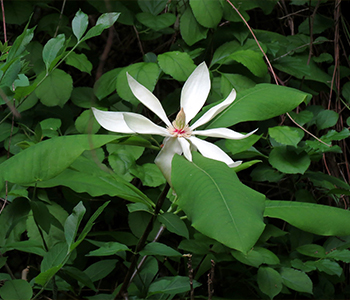Umbrella Magnolia
Magnolia tripetala
Overview
Only growing from 15 to 30 feet tall (and 15 to 30 feet wide), the Umbrella Magnolia is a relatively small tree. Native to the southeastern US, mainly in the Appalachian Mountains, its gry bark is smooth and its leaves, large. The leaves lay in clusters at the end of the tree's branches, resembling an umbrella. There are also 4 to 6 inch long fruit that have a knobby surface that grow reddish-orange seeds in August and September.
Cultivation
The Umbrella Magnolia prefers full or partial sunlight with some shade throughout the day. When it comes to soil, it prefers it moist and well-drained. The tree can also tolerate alkaline soil as well. This tree grows at a moderate rate.
Biodiversity Sustained
The Umbrella Magnolia is food and shelter to various birds, insect pollinators, and other small mammals. Like all Magnolias, animals can use this tree as both short and long-term shelter. Some birds use it as short-term refuge when migrating. Other birds, like songbirds, use it as a long-term home.
On Xavier's Campus, over the Next 20 Years, this Tree will:
Stormwater Runoff Intercepted: 3,472 Gallons
CO2 Reduction: 1,650 lbs
Electricity Savings: 379 kilowatt/hours
Environmental Benefits (in US dollars): $489
